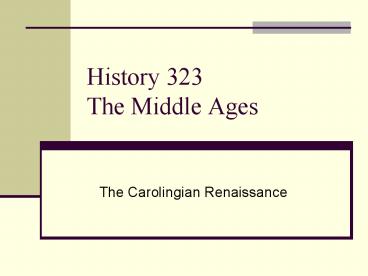History 323 The Middle Ages - PowerPoint PPT Presentation
1 / 19
Title:
History 323 The Middle Ages
Description:
The most important Carolingian king was named Charlemagne (768-814), also called ' ... are depicted doing basic tasks in a manuscript showing calendar and zodiac ... – PowerPoint PPT presentation
Number of Views:94
Avg rating:3.0/5.0
Title: History 323 The Middle Ages
1
History 323The Middle Ages
- The Carolingian Renaissance
2
King Charlemagne
- The most important Carolingian king was named
Charlemagne (768-814), also called "Charles the
Great - He was the son of Pepin the Short and the
grandson of Charles Martel - Coronated Holy Roman Emperor in 800 by the Pope
- Einhard, Charlemagnes biographer, described him
as pure of body and heart. Why did he emphasize
both physical and moral purity?
A contemporary and realistic statue of
Charlemagne (mid-800s)
3
(No Transcript)
4
Life Among the Carolingians
Reconstruction of basic Frankish dwellings for
people and animals among the Carolingians, c. 800
5
Above Large, one-roomed house, animal, and
fodder pens, c. 800 Left Frankish workers are
depicted doing basic tasks in a manuscript
showing calendar and zodiac
6
Life Among the Carolingians
A Christian Church from the Carolingian period
(9th century) Romanesque in style and a rather
plain in the interior (Western Germany)
7
Frankish Burial Practices
8
Frankish Burial Practices
9
Expansion and Administration
- The Carolingians ruled by military expansion.
Charlemagne was a Germanic king who controlled
warrior-aristocrats that survived by continually
conquering new land - Charlemagne appointed counts to supervise local
administration within his territories. These men
supervised the courts, collected tolls,
administered crown lands, and taxed - Dukes were appointed as military leaders.
Bishops managed religious issues and controlled a
few cities in place of counts - Charlemagne created a new coinage system based on
silver - He administered the kingdom using written records
and instructions called capitularies - He sent representatives from his court (missi) on
tours throughout the countryside to relay his
instructions personally - He lived in the capital city of Aachen (Germany)
but traveled around too, leading armies,
supervising counts and dukes, and listening to
complaints
10
Social Arrangements and Feudalism
- Charlemagne had no standing armypower was built
on the ability to assemble temporary armies each
spring, win battles, and gain booty - To gain support, Charlemagne established feudal
relationships with local nobleshe gave them land
or power in exchange for their military support - This relationship was sealed with a formal oath,
and the local noble became a vassal of the king
King Charlemagne and his knights visit a duke
11
The Carolingian Renaissance
- The Carolingian Renewal or Renaissance was a
rebirth of the artistic and scholarly activities
which had been the crowning achievements of
ancient Rome, but had been lost in the more
primitive cultures of the early Middle Ages in
Western Europe - This rebirth was fuelled by Carolingian wealth
and the scholarly activity of Alcuin, a highly
educated advisor of King Charlemagne
An illustrated copy of the Psalms
12
Carolingian Miniscule
- Over time, the Carolingians developed a new,
clearer way of writing Latin called Carolingian
Miniscule - Previous texts were all uppercase, without
punctuation or spaces - The new minuscule script was written in upper and
lower case letters and abbreviations - Several monasteries then specialized in the
production of hand copied texts using the new
methodbooks became popular again
A 9th century Carolingian text
13
Carolingian Musical Notation
The Carolingians were the first to introduce
musical notation in Europe, at first just tiny
squiggles without a staff along side Gregorian
Chant
Later texts featured staffs and polyphony
(harmony), such as this 12th century text
14
Carolingian Art
- Carolingian artists embellished church interiors,
created statues, and executed wall paintings like
late Romans artists - They excelled especially at painting and
decorating sacred manuscripts, such as this
liturgical book for the Mass, created during the
reign of Charles the Bald (d. 877), grandson of
Charlemagne - Note the geometric patterns reminiscent of
Byzantine, Islamic or medieval Irish art
15
Carolingian Art
Ivory book covers for a Psalter (Psalm
collection), 794 A.D. near Paris This carving
style is influenced by Roman sculpture (note
drapery and classical styling). It depicts King
David and his court in several scenes (a favorite
ruler of the Franks)
16
Carolingian Book Making
The Lorscher Evangeliar (Gospel)
17
Charlemagnes Relics
This later shrine was created to hold
Charlemagnes skull and other relics. Notice how
idealized the famous king now looks! Why might
his body be a source of special interest for
medieval Europeans?
18
History, Literature, and Court Culture
- The importance of writing history and literature
were restored, and Carolingians created their own
literary works, as well as copying and preserving
the writings of the ancient world - Einhards Life of Charlemagne is a good example
of Carolingian history writing (compare with
Plutarchs Life of Alexander) - After the 774 invasion of Italy, Carolingian
court culture became an imitation of Italian
court culture - Alcuin, an English scholar (York) who organized
education and writing at Charlemagnes court, was
the primary innovator
Interior of Charlemagnes Aachen Cathedral, 805
A.D.
19
Carolingian Law
- Charlemagne was the most systematic among the
Franks in creating laws that could be
consistently administered through his Empire - The laws were written in Latin and carried by
missi throughout the realm. Local courts
enforced them - For example, the Saxon Capitularies (775-790)
listed numerous laws for a newly conquered
Germanic (pagan) group called the Saxons in North
Germany, including the following law - 16. All infants shall be baptized within a
year and if any one shall have despised to bring
his infant to baptism within the course of a
year, without the advice or permission of the
priest, if he is a noble he shall pay 120 solidi
to the treasury, if a freeman 60, if a litus 30.































